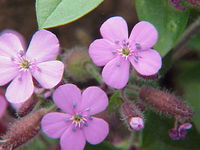Difference between revisions of "Saponin"
From eagle-rock.org
(Created page with "Saponins are found in many plants. Saponins are glycosides. Like soap they lather when they are mixed with water. Soapwort has a high saponin content and can be used to make n...") |
|||
| Line 1: | Line 1: | ||
| + | [[File:Saponaria ocymoides, Soapwort species - Wikimedia Commons.jpg|200px|thumb|right|Saponaria ocymoides, a soapwort species. Soap can be made from the crushed leaves and roots of soapwort.]] | ||
Saponins are found in many plants. Saponins are glycosides. Like soap they lather when they are mixed with water. Soapwort has a high saponin content and can be used to make natural soap. Saponins have an expectorant effect on the body (bring up mucus from the lungs), are diuretic (elevate the rate of urination), and are said to be beneficial for the circulatory system. | Saponins are found in many plants. Saponins are glycosides. Like soap they lather when they are mixed with water. Soapwort has a high saponin content and can be used to make natural soap. Saponins have an expectorant effect on the body (bring up mucus from the lungs), are diuretic (elevate the rate of urination), and are said to be beneficial for the circulatory system. | ||
Latest revision as of 20:05, 20 January 2012
Saponins are found in many plants. Saponins are glycosides. Like soap they lather when they are mixed with water. Soapwort has a high saponin content and can be used to make natural soap. Saponins have an expectorant effect on the body (bring up mucus from the lungs), are diuretic (elevate the rate of urination), and are said to be beneficial for the circulatory system.

